Magnify the tooth 1000 times, so you can see its truest appearance
In a sense, the mouth is the dirtiest place in the human body. It is estimated that there are more than 400 species of bacteria in the human mouth.
Plaque is a bacterial population that attaches to teeth. Using a microscope with a focused electron beam, the scientists magnified the tooth 1,000 times and photographed the tooth and its attached bacteria.
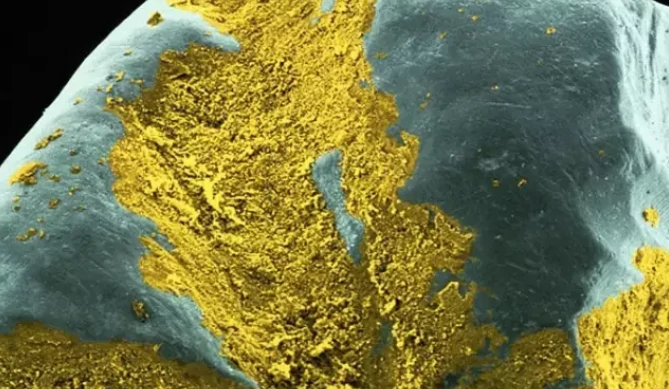
Yellow plaque attached to the surface of the blue tooth
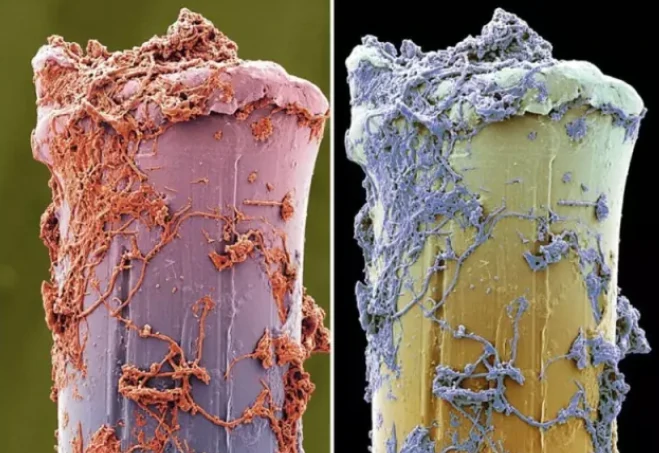
Dental plaque in the pink and purple coat
The staff made the pictures into color, to let people see more clearly the punctate bacteria lurking in the teeth and the plaque formed by the bacteria attached to the teeth.
The culprit of periodontitis is plaque
Bacteria in the oral cavity are not alone. They adhere to the surface of the teeth or the mucosal surface of the oral cavity through saliva and other substances to form dental plaque.
Even freshly cleaned teeth can develop new plaque in minutes. After 12 hours, the plaque will initially mature.
This plaque may irritate the local gums, causing periodontitis.
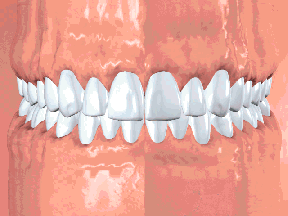
The process by which normal gums develop into periodontitis
Dental calculus we often say is actually mineralized dental plaque. The accumulation of calculus will “run” under the gums, causing the gums to recede, eventually causing the teeth to loosen or even fall out.
Mild periodontitis manifests as red and swollen gums, bleeding from brushing, and bad breath;
Moderate periodontitis can cause inability to chew, sore gums, receding gums, and exposed tooth roots.
Severe periodontitis will cause symptoms such as tooth loosening, displacement, pain, inability to chew food, and eventually tooth loss.
6 signs of plaque buildup
If brushing is not timely or thorough, plaque can lead to tooth decay and calculus. When there is too much plaque, there are several signs that can appear early, and early identification can prevent oral problems from getting worse.
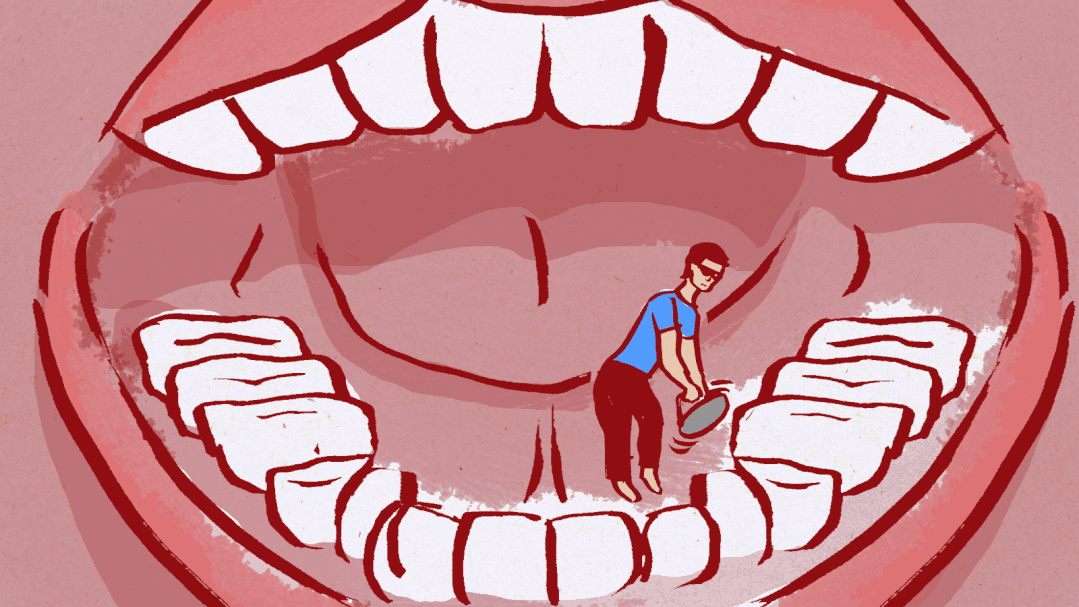
- The tooth surface is not smooth
When plaque builds upon the surface of the teeth, when touched with the tongue, the surface of the teeth will feel rough.
This often happens in the morning before you brush your teeth, and if it persists throughout the day, it could be a sign that plaque is building up.
- Bad breath
Plaque contains bacteria, which produce an unpleasant odor.
- Yellow teeth
When plaque “grows” on the teeth, the film can make the teeth appear dull white, or yellow.
- Red, swollen or bleeding gums
Too much plaque can irritate the gums, making them swollen and painful, causing gingivitis. Bleeding when brushing your teeth after periodontitis.
- Tartar buildup
When plaque is not removed for a long time, it hardens into tartar, calculus, which often appears at the junction of the gums and teeth and looks yellow or brown.
- Sensitive teeth
Over time, plaque can cause gums to recede, which can make teeth feel more sensitive. Soreness when inhaling cold air, cold or hot food, or water.
Brush your teeth after meals to prevent the teeth from being corroded by acid
Periodontitis is a preventable disease. After eating, the oral environment will become “sour”. 12 minutes after a meal is the peak period of bacterial fermentation of carbohydrates to produce acid.
■ Studies have shown that the pH of the oral cavity begins to decrease after eating, and it drops to the lowest level in about 12 minutes. After half an hour, most people’s oral pH will return to normal levels.
■ The oral pH of some people with severe caries activity was lower than the critical value from the beginning; half an hour later, their tooth enamel was still in a demineralized state and was still fragile; after 1 hour, it had not returned to the normal level.
For most people, brushing your teeth early can interfere with and block this process, reducing the risk of acid erosion. Additionally, brushing your teeth once a day was associated with a 9% lower risk of cardiovascular disease and an 8% lower risk of diabetes.
Therefore, in addition to brushing in the morning and evening, it is best to brush after every meal. If not available, rinse your mouth with water.
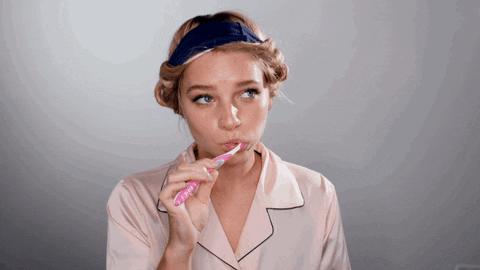
There is nothing wrong with brushing your teeth immediately after eating a normal diet. People who are worried about brushing their teeth to damage the enamel should pay more attention to the brushing method and the choice of the toothbrush.
Ways to get rid of dental plaque
Plaque may produce acid and decalcify to form dental caries, or secrete toxins against periodontal tissue. Therefore, the most important thing in daily dental care is to remove plaque to prevent dental caries and periodontitis.
Brush your teeth with the Pasteur method
When brushing your teeth, stick to the Pasteur brushing method, also known as gingival sulcus sweeping or horizontal fluttering.
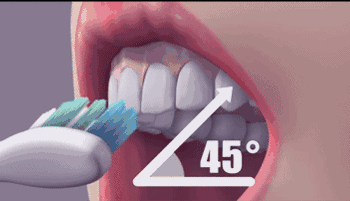
This cleans the plaque better without damaging the teeth and gums. Brush your teeth within 30 minutes after meals, at least 3 minutes each time, and choose a toothbrush with soft bristles.
Use mouthwash
Based on proper brushing, mouthwash can help inhibit plaque growth. If you choose a medical prescription mouthwash, you should first ask your doctor if it can be used for a long time.
Use dental floss
Simply brushing your teeth can only remove about 2/3 of the plaque, and the rest are hidden between the teeth, under part of the gingival margin, and in the dead corners caused by the misalignment of the teeth, which can easily lead to adjacent surface caries, gingival inflammation and other symptoms.
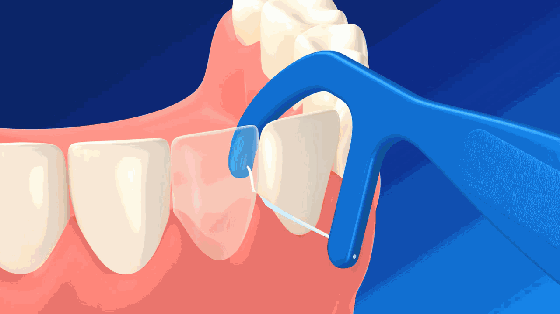
Regular teeth cleaning
Scaling is the most effective way to remove plaque and tartar. Brushing your teeth every six months to a year can prevent bleeding gums and loose teeth, effectively prevent periodontal disease, and help maintain oral health.
Use a dental irrigator
The irrigator can irrigate any part of the mouth through the nozzle, including between the teeth and deep gums where the toothbrush and floss are not easy to reach. It is recommended to rinse for 1-3 minutes after each meal.
Use a gap brush
For those with larger gaps, a gap brush can be used. Interstitial brushes are single-bristle brushes designed to remove plaque from larger interdental spaces, as well as aligners, fixed restorations, implants, gap retainers, and other hard-to-reach areas. The size of the gap brushes is different, which can be selected according to personal conditions and cleaning parts.
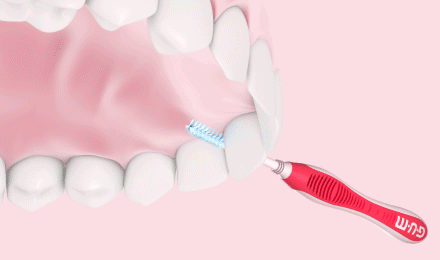
To remove plaque, different groups of people should pay attention to different issues:
Elderly people with large gaps between their teeth can use more brushes. Middle-aged people are prone to get angry, and their gums are inflamed, swollen, and bleeding. Use a soft-bristled toothbrush. Children who have difficulty brushing their teeth can use an electric toothbrush.
It should be noted that if you use an electric toothbrush if you have bleeding gums, periodontal disease, or repair teeth, the speed should not be turned to the maximum.